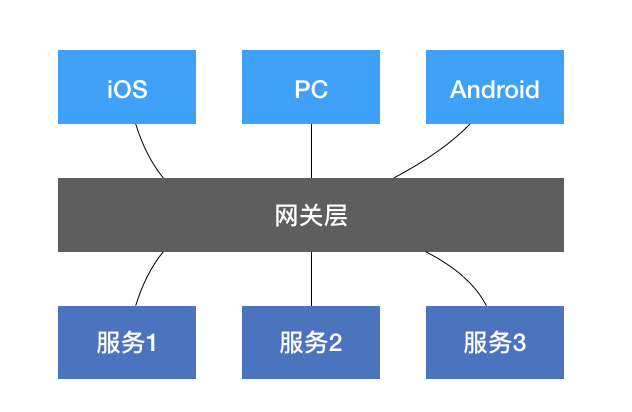什麼是 API 網關? 所謂網關,主要作用就是連接兩個不同網路的設備,而今天所講的 API 網關是指承接和分發客戶端所有請求的網關層。 為什麼需要網關層?最初是單體服務時,客戶端發起的所有請求都可以直接請求到該服務,但隨著產品用戶越來越多,單體應用存在顯而易見的單點問題,除此之外,當單體應用大小升至 ...
什麼是 API 網關?
所謂網關,主要作用就是連接兩個不同網路的設備,而今天所講的 API 網關是指承接和分發客戶端所有請求的網關層。

為什麼需要網關層?最初是單體服務時,客戶端發起的所有請求都可以直接請求到該服務,但隨著產品用戶越來越多,單體應用存在顯而易見的單點問題,除此之外,當單體應用大小升至幾個 G 時,持續發佈將會非常緩慢,所以服務的拆分成為了必然趨勢。

當服務拆分為多個之後,我們不得不面臨一個問題,就是如何控制用戶請求到對應服務節點,於是網關層應運而生,它不僅可以負責負載均衡,還可以讓它處理認證校驗、請求限流、日誌記錄以及監控服務節點等等。

當然,網關層並不需要我們手動實現,市面上有很多 API 網關開源項目,比如 Zuul、Kong、Tyk 等,今天主要介紹 Kong。
安裝 Kong
Kong 是一個在 Nginx 中運行的 Lua 程式,由 lua-nginx-module 實現,和 Openresty 一起打包發行,支持多種操作環境下的安裝,可以用來做 HTTP 基本認證、密鑰認證、TCP、UDP、文件日誌、API 請求限流、請求轉發等等。
第一步,創建一個 docker 網路。
$ docker network create kong-net
創建用於存儲 Kong 數據的資料庫,可以使用 Cassandra 或 PostgreSQL,本示例採用 Cassandra。
Cassandra 是由 Facebook 開發的分散式 NoSQL 資料庫。
$ docker run -d --name kong-database \
--network=kong-net \
-p 9042:9042 \
cassandra:3
初始化數據到 Cassandra 資料庫。
$ docker run --rm \
--network=kong-net \
-e "KONG_DATABASE=cassandra" \
-e "KONG_PG_HOST=kong-database" \
-e "KONG_PG_PASSWORD=kong" \
-e "KONG_CASSANDRA_CONTACT_POINTS=kong-database" \
kong:latest kong migrations bootstrap
啟動 Kong 容器連接資料庫。
$ docker run -d --name kong \
--network=kong-net \
-e "KONG_DATABASE=cassandra" \
-e "KONG_PG_HOST=kong-database" \
-e "KONG_PG_PASSWORD=kong" \
-e "KONG_CASSANDRA_CONTACT_POINTS=kong-database" \
-e "KONG_PROXY_ACCESS_LOG=/dev/stdout" \
-e "KONG_ADMIN_ACCESS_LOG=/dev/stdout" \
-e "KONG_PROXY_ERROR_LOG=/dev/stderr" \
-e "KONG_ADMIN_ERROR_LOG=/dev/stderr" \
-e "KONG_ADMIN_LISTEN=0.0.0.0:8001, 0.0.0.0:8444 ssl" \
-p 8000:8000 \
-p 8443:8443 \
-p 0.0.0.0:8001:8001 \
-p 0.0.0.0:8444:8444 \
kong:latest
通過 curl 模擬請求本地 8001 埠可以獲取 Kong 的詳細信息。截止目前整個 kong 服務就跑起來了,接下來可以註冊服務節點到 kong 中。
$ curl -i http://localhost:8001/
註冊服務
註冊名為 baidu-service 的服務到 kong,如果請求匹配到該服務會跳轉至 url。
$ curl -i -X POST \
--url http://localhost:8001/services/ \
--data 'name=baidu-service' \
--data 'url=http://baidu.com'
註冊成功之後會得到如下提示。
HTTP/1.1 201 Created
Date: Sat, 16 May 2020 06:35:56 GMT
Content-Type: application/json; charset=utf-8
Connection: keep-alive
Access-Control-Allow-Origin: *
Server: kong/2.0.4
Content-Length: 292
X-Kong-Admin-Latency: 103
{"host":"baidu.com","created_at":1589610956,"connect_timeout":60000,"id":"6660aaa7-5afa-4f02-85f8-11dfb81fba84","protocol":"http","name":"baidu-service","read_timeout":60000,"port":80,"path":null,"updated_at":1589610956,"retries":5,"write_timeout":60000,"tags":null,"client_certificate":null}
服務配置路由
服務添加成功後,需要告知 kong 什麼樣的請求才使用該服務,而這個規則被稱為 route,也就是路由,路由的作用是按規則匹配客戶端的請求,然後轉發到對應的 service,每個 route 都對應一個 service,一個 service 可能有多個 route。
$ curl -i -X POST \
--url http://localhost:8001/services/baidu-service/routes \
--data 'hosts[]=baidu.com'
以上代碼的作用是當請求功能變數名稱是 baidu.com 時,則將請求轉發到 baidu-service 指定的 url,我們可以通過 curl 模擬測試。
$ curl -i -X GET \
--url http://localhost:8000/ \
--header 'Host: baidu.com'
HTTP/1.1 200 OK
Content-Type: text/html; charset=UTF-8
Content-Length: 81
Connection: keep-alive
Date: Sat, 16 May 2020 06:45:12 GMT
Server: Apache
Last-Modified: Tue, 12 Jan 2010 13:48:00 GMT
ETag: "51-47cf7e6ee8400"
Accept-Ranges: bytes
Cache-Control: max-age=86400
Expires: Sun, 17 May 2020 06:45:12 GMT
X-Kong-Upstream-Latency: 92
X-Kong-Proxy-Latency: 17
Via: kong/2.0.4
<html>
<meta http-equiv="refresh" content="0;url=http://www.baidu.com/">
</html>
負載均衡配置
與 nginx 同理,先創建一個 upstream,名為 hello。
$ curl -X POST http://localhost:8001/upstreams --data "name=hello"
{"created_at":1589633009,"hash_on":"none","id":"3bab80bb-7e62-40c8-8b7c-7efdcc329675","algorithm":"round-robin","name":"hello","tags":null,"hash_fallback_header":null,"hash_fallback":"none","hash_on_cookie":null,"host_header":null,"hash_on_cookie_path":"\/","healthchecks":{"threshold":0,"active":{"https_verify_certificate":true,"type":"http","http_path":"\/","timeout":1,"unhealthy":{"http_statuses":[429,404,500,501,502,503,504,505],"tcp_failures":0,"timeouts":0,"http_failures":0,"interval":0},"healthy":{"http_statuses":[200,302],"interval":0,"successes":0},"https_sni":null,"concurrency":10},"passive":{"unhealthy":{"http_failures":0,"http_statuses":[429,500,503],"tcp_failures":0,"timeouts":0},"healthy":{"http_statuses":[200,201,202,203,204,205,206,207,208,226,300,301,302,303,304,305,306,307,308],"successes":0},"type":"http"}},"hash_on_header":null,"slots":10000}
為 upstream 添加兩個負載均衡的節點,我就拿京東和淘寶來做測試了。
curl -X POST http://localhost:8001/upstreams/hello/targets --data "target=jd.com" --data "weight=100"
curl -X POST http://localhost:8001/upstreams/hello/targets --data "target=taobao.com" --data "weight=50"
如上配置就相當於 nginx 中的
upstream hello {
server jd.com weight=100;
server taobao.com weight=50;
}
接下來創建一個 service 指向 upstream,host 即對應 upstream 名。
curl -X POST http://localhost:8001/services --data "name=hello" --data "host=hello"
為 service 創建路由,凡是包含 /hello 的地址全部走 hello upstream。
curl -i -X POST --url http://localhost:8001/services/hello/routes --data 'paths[]=/hello'
curl -X POST --url http://localhost:8001/routes --data 'paths[]=/hello' --data 'service.id=8ad06aa5-be0a-4763-a84d-90b8046765f5'
現在訪問 localhost:8000 就可以看到已經成功做了負載均衡。
限流
因為伺服器不能處理無限量的請求,為了避免請求數高到伺服器無法處理,必須做限流操作。關於限流,kong 使用了 rate-limiting 插件,它可以在 service、route、consumer 不同粒度上控制請求,配置非常簡單。
curl -X POST http://kong:8001/services/{service}/plugins \
--data "name=rate-limiting"
--data "config.second=5" \
--data "config.hour=10000"
config.second 代表一秒鐘內處理的最大請求次數,config.hour 表示一小時內最大請求次數。
Route 的示例
curl -X POST http://kong:8001/routes/{route}/plugins \
--data "name=rate-limiting"
--data "config.second=5" \
--data "config.hour=10000"
Consumer 的示例
curl -X POST http://kong:8001/consumers/{consumer}/plugins \
--data "name=rate-limiting-advanced" \
--data "config.second=5" \
--data "config.hour=10000"
原文首發:https://pingyeaa.com/2020/05/16/architecture/gateway-kong/
我是平也,這有一個專註Gopher技術成長的開源項目「go home」
感謝大家的觀看,如果覺得文章對你有所幫助,歡迎關註公眾號「平也」,聚焦Go語言與技術原理。



